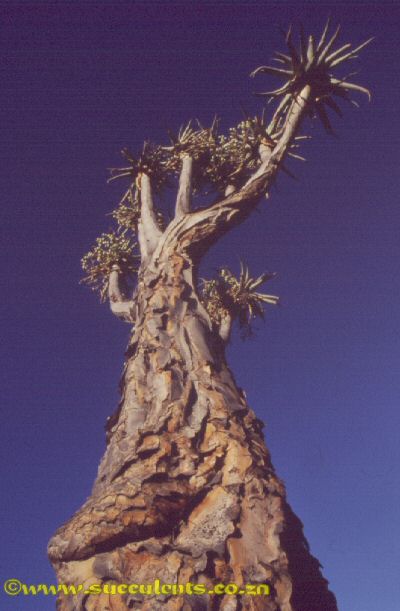Aloe pillansii |
SL. Guthrie
Asphodelaceae - CITES App. II |
Aloe pillansii is named after Neville S. Pillans, a well-known Cape botasnist who first collected Aloe pillansii. Aloe pillansi has been placed on the endangered specie list due to ove-grazing and collecting.
Aloe pillansii South African national tree number is 30.
Aloe pillansii is not easily mistake for Aloe dichotoma. Aloe pillansii can be easily distinguished from a Quiver Tree by looking at the inflorescence that is borne almost horizontally from the rosette. Aloe pillansii is also far more robust than Aloe dichotoma. |
| Common Names: |
Giant Quiver Tree, Reusekokerboom. |
| Status: |
Endangered due to overgrazing and collection. |
| Distribution: |
Aloe pillansii occurs from Cornell's Kop in the Richtersveld northwards to Brandberg in Namibia. |
| Description of Aloe pillansii: |
| The yellowish-grey trunk splits dichotomously into erect branches, that never spread and terminate in large rosettes of thick fleshy greyish-green leaves (600mm in length). The leaves are falcately deflexed and have whitish-cartilaginous edges with cartilaginous teeth. |
Flower Description : |
| Inflorescence is branched and downward facing and flowers are yellow in colour and slightly swollen in the middle. |
| Flowering Time: |
Aloe pillansii flowers in October. |
Cultivation of Aloe pillansii: |
| Light: |
Full sun. |
| Watering: |
Careful watering. |
| Frost Protection: |
Required. |
| Notes: |
Aloe pillansii is and easy plant to cultivate. A well drained soil is required, with careful watering. Full sun is required and frost protection in winter is required. (USDA 8 - 10). |
Picture: Aloe pillansii in habitat in the Richtersveld.

Photographer: Philip Desmett
|